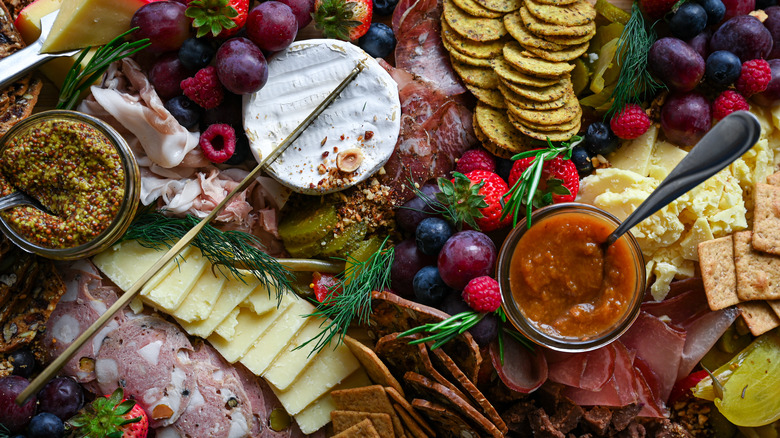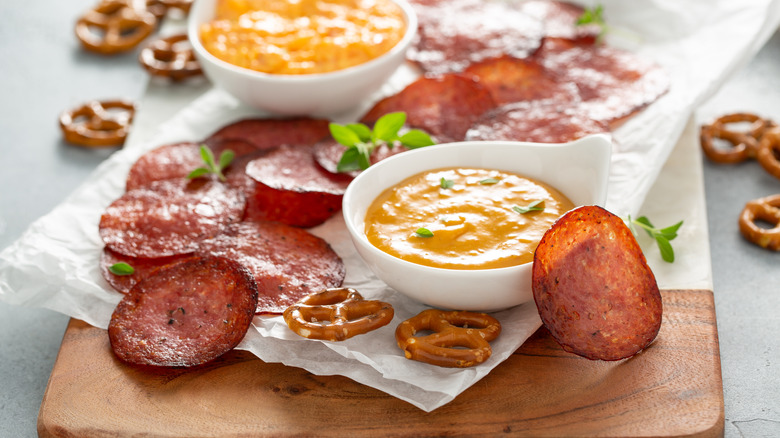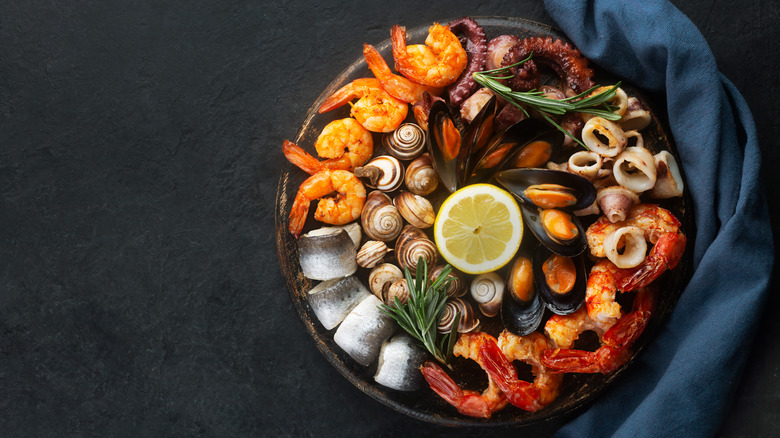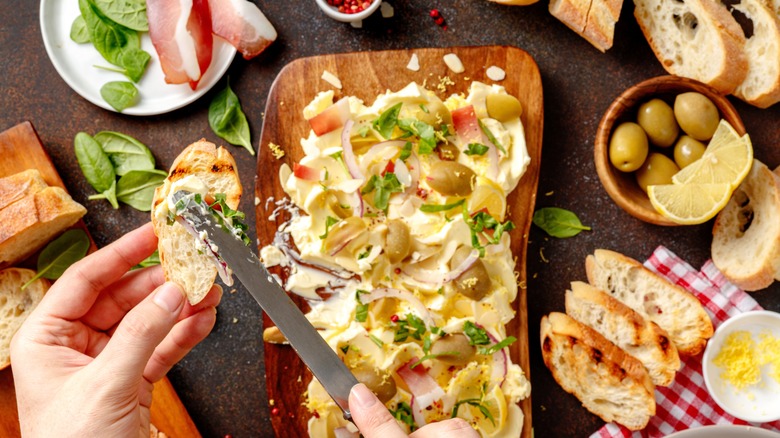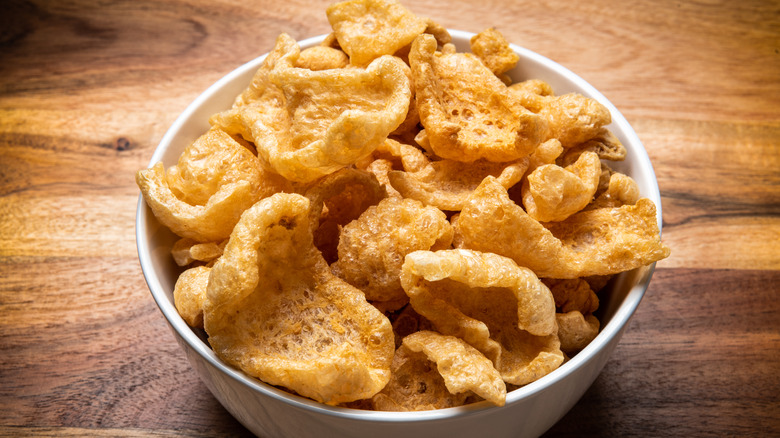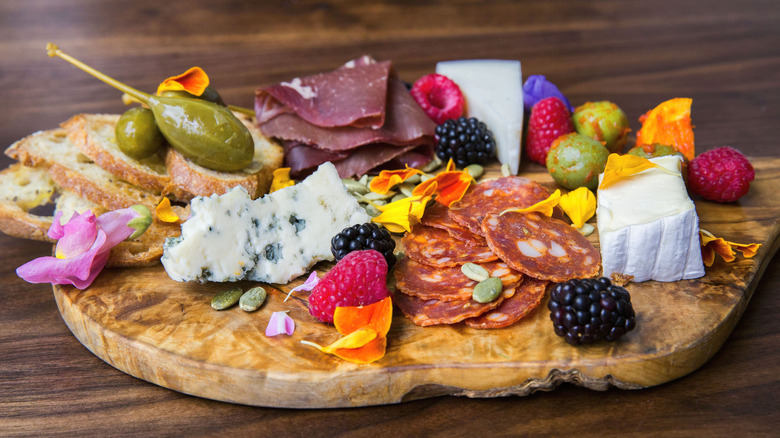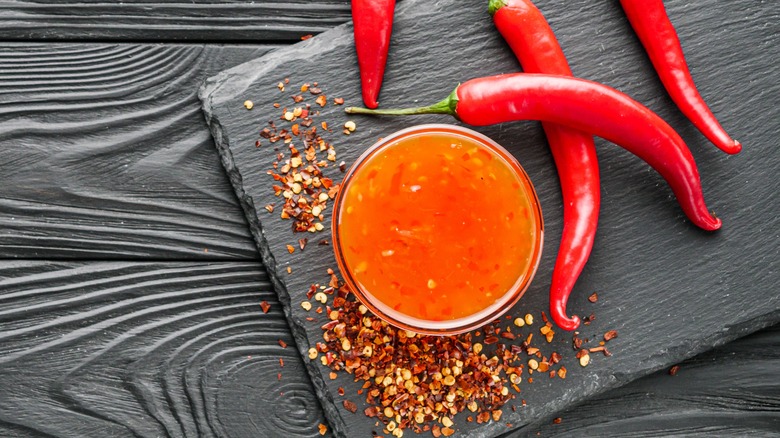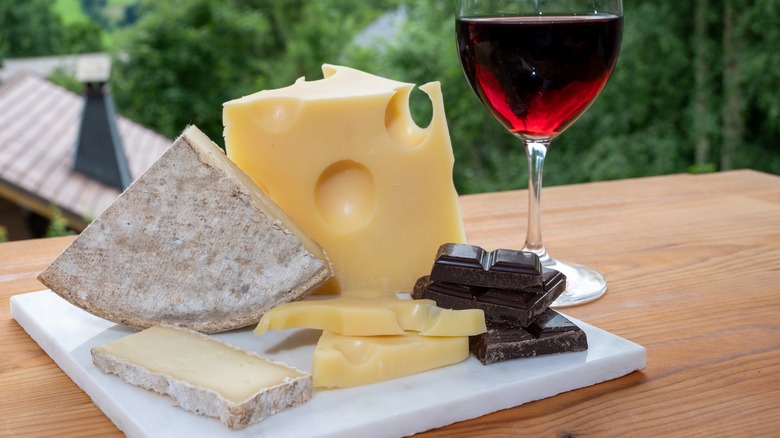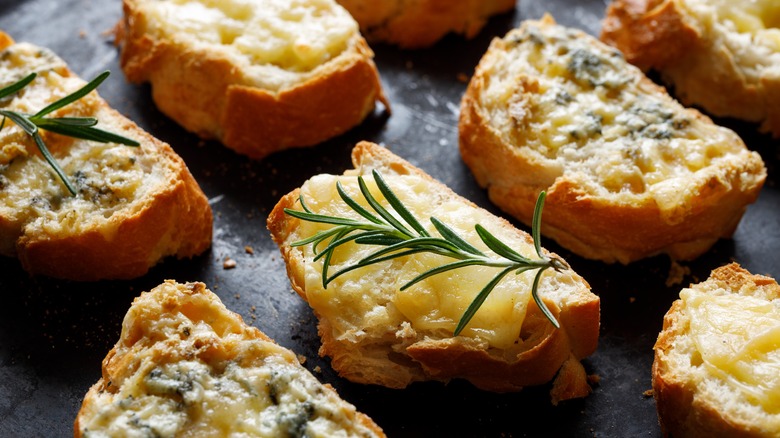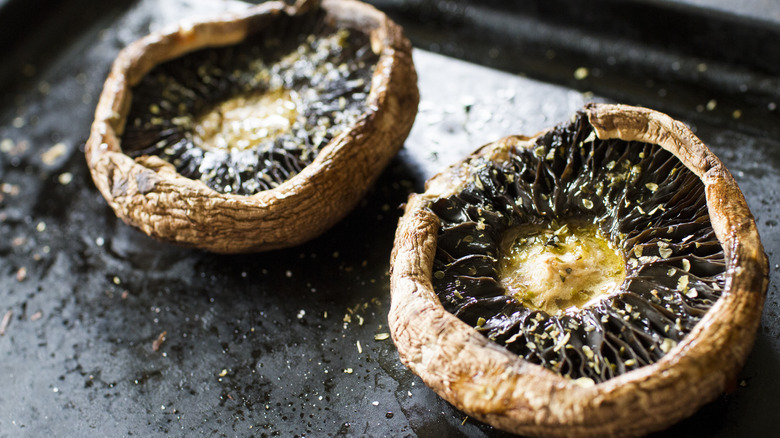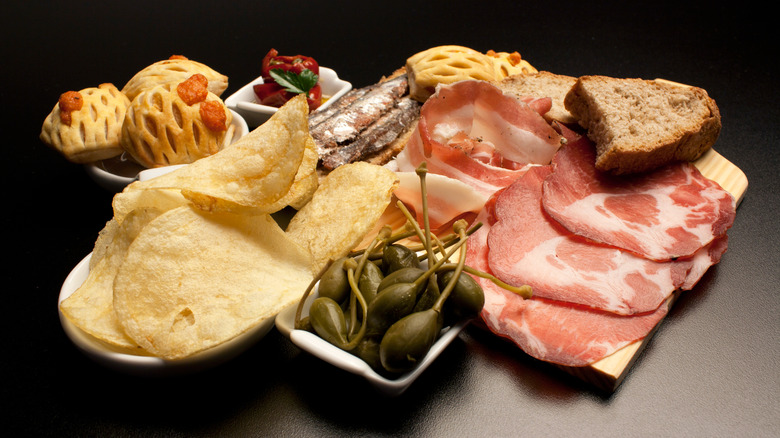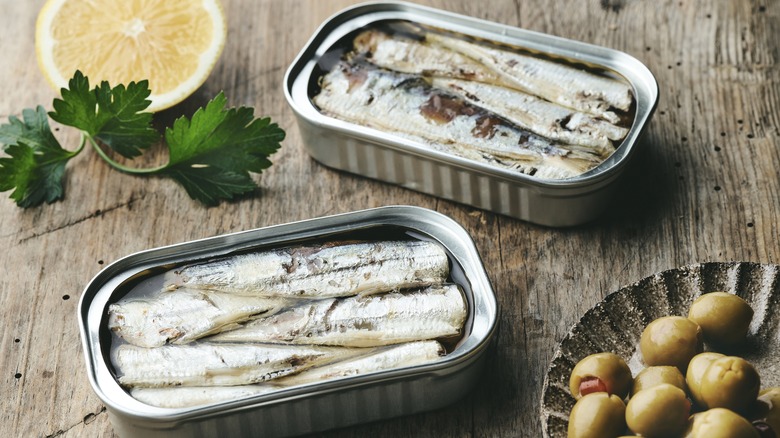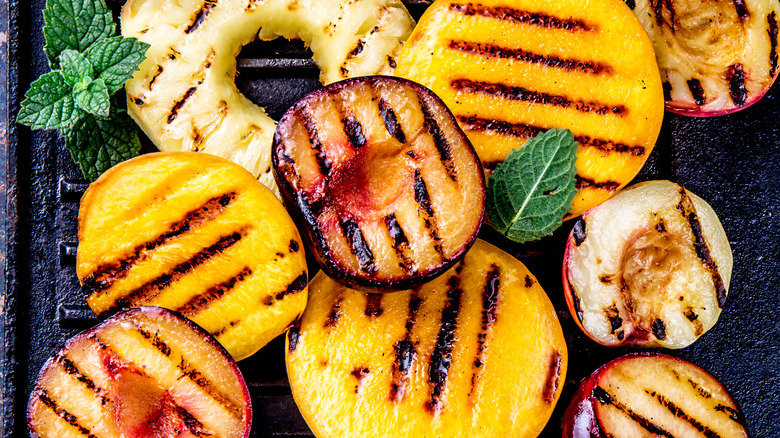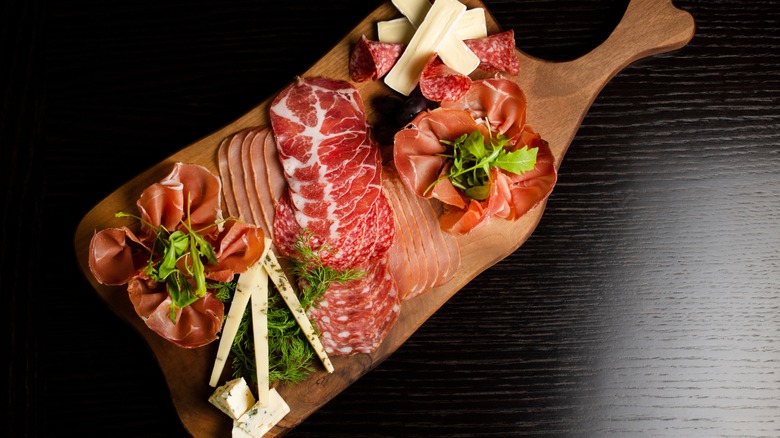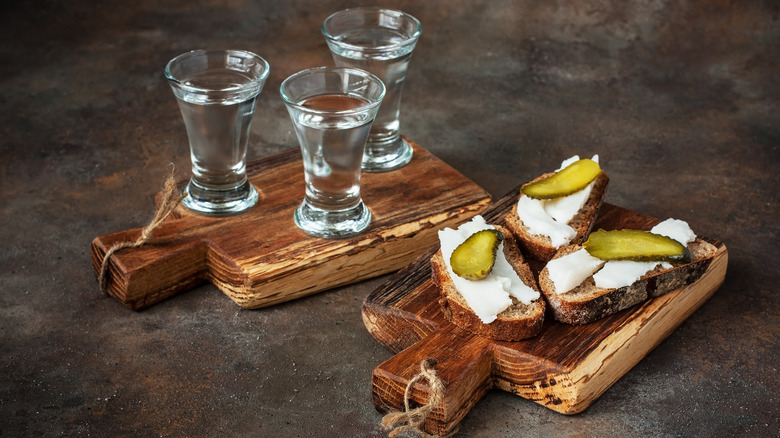14 Ingredients You May Not Have Thought To Add To A Charcuterie Board
The word charcuterie technically refers to cured meats. This type of food traditionally takes up a good amount of space on a charcuterie board. When combined with other foods — such as cheeses, dips, and fresh produce — a charcuterie board is an ideal dish for gatherings. These platters allow guests to graze as they like, choosing from a variety of flavors to enjoy.
Nowadays, a charcuterie board doesn't even have to include cured meats. The term is more generally used to refer to all kinds of snack spreads. Your creativity is the only limit when it comes to composing a charcuterie board. You can put one together for anyone, no matter what their taste preferences or dietary restrictions may be.
The key things to keep in mind for your board are variety and balance. You want a range of textures and flavors that can work together to create satisfying bites. You also want the board to be visually appealing, with a spectrum of attractive colors and surfaces. If you're looking for charcuterie board inspiration, here are some unconventional ingredients you can include to impress guests at your next gathering.
1. Spreadable cheeses
When choosing cheeses for a charcuterie plate, it's important to select a variety. Typically this means at least one soft, one semi-firm, and one hard cheese. But there's another cheese category that often gets overlooked: spreadable cheese. A layer of creamy cheese spread on a slice of baguette or a cracker makes the perfect base on which to layer other charcuterie board ingredients. These cheeses can even add richness and a pop of flavor.
Boursin makes excellent, spreadable cheese that you can add to your board. This brand is known for its flavored dairy products which are designed to be extra soft. They also come in a range of flavors. Boursin's original cheese is flavored with garlic and herbs.
If you want to add some Southern spice to your board, go for pimento cheese. This tangy, pepper-studded cheddar spread is usually a crowd-pleaser. Pub cheese — also called beer cheese, if it's made with the addition of this alcoholic beverage — is another great option. If you go for a homemade cheese spread, you can personalize it by making it with your favorite dairy products, spices, and herbs.
2. Shrimp
To add some surf to your traditionally turf-filled charcuterie board, you can use shrimp. These creatures are an excellent fit, as you don't need utensils to eat them. Plus, they're mild in taste, so they won't clash with other flavors. Their natural mildness also means that you can season them to your liking. This way you can modify your shrimp to suit the rest of your ingredients or the theme of your board.
Shrimp can be prepared in a multitude of ways. For a delicate texture and flavor, poach shrimp in a gently seasoned broth. Grilling or frying shrimp will add more intensity. Once cooked and added to your board, shrimp can be safely left at room temperature for up to two hours. According to the FDA, this type of seafood can stay out longer if they are kept on ice.
These shellfish can also be served alongside a dip. You can opt for a classic tangy and spicy cocktail sauce, or something unique like a yogurt-chutney dipping sauce. Keep size in mind when purchasing shrimp for your charcuterie spread. You want each shrimp to be easy to hold and finish in one bite. Don't choose big shrimp, these will also take over the board.
3. Flavored butters
If you're active on social media, you've likely come across the butter board trend. It's a simple concept. Butter boards take inspiration from charcuterie boards but instead focus on dairy.
Basically, softened butter is spread over a cutting board or platter, then topped with various flavorings and garnishes. Guests then swipe their pieces of bread or crackers through the butter, scooping up all of the tasty, buttery goodness. Since butter makes everything better, there's no reason not to add a butter board-inspired component to your next charcuterie board.
Flavored butters — also called compound butters — don't need to be spread on a board to be enjoyed with charcuterie. Compound butter can be served soft, in bowls or ramekins. It can also be served slightly firmer, in whole or sliced logs. There's no limit to what ingredients you can use to flavor butter, so don't be afraid to get creative. Sweet, savory, spicy, or any combination thereof can become an interesting charcuterie board companion. Add chopped fruit and honey to make a sweet compound butter that's delicious when eaten with a piece of salty cheese. You could also make a herb and citrus butter to brighten up rich, fatty meats.
4. Pork rinds
Crackers, bread, and small toasts are all fine vessels for charcuterie board ingredients. But if you want something different, you can double the meat on your board by using pork rinds. These treats offer the same satisfying crunch as crackers, along with a savory flavor that goes well with cured meats and cheeses. Plus, if you have guests who are avoiding carbohydrates or gluten, these snacks are a perfect solution.
There are countless brands of pork rinds on the market. They come in many varieties, just like chips. You can even purchase plain rinds and season them yourself to match them up with the rest of your board. Most rinds take well to most flavors. Pork rinds can also be made from scratch, but it's quite an undertaking and involves tracking down pork skin from a butcher. Good quality, store-bought pork rinds are easy to find, so you can save yourself the work and simply purchase a bag.
5. Edible flowers
At least half the fun of a charcuterie board is in the presentation. The more visually appealing you make your board, the more likely your guests are going to want to dive in and enjoy everything it has to offer. A big part of the appeal is color. Meats and cheeses tend to all sit in the same range of tones, which can look rather bland when they're all piled together in pink, brown, and cream hues. Fresh fruits and vegetables are a great way to add pops of brightness. But if you want to really impress with vibrant color, you can add edible flowers, too.
Edible flowers can be found at many markets in the produce section, or easily ordered online. They make stunning garnishes that can be safely consumed. These flowers even add their own unique aromas and flavors to food.
A few to look for are peppery nasturtiums and delicately onion-tasting chive blossoms. Both of these go well with savory meats and cheeses. Just make sure you are using flowers that are specifically made for consumption, as decorative flowers can be treated with pesticides or other chemicals, making them inedible.
6. Hot sauce
When serving food to a group, it's always good to keep in mind that not everyone has the same palate. What's bland to one person can be too much for another. This is particularly true when it comes to levels of spiciness.
In any band of diners, there's bound to be at least one person who loves spicy food and another who recoils at the slightest whiff of pepper. Since a charcuterie board is built to have something to please everyone, you want to keep things mild for the mellow eaters. But it's also nice to give the firebreathers the option to take their bites to the next level.
The easiest way to do this is to include hot sauce. A bottle on the side of the board is fine, especially for thinner, vinegar-based sauces. For thicker sauces like chili crisp, you might want to put out a small bowl with a spoon. This way, folks can easily ladle the heat onto their charcuterie bites. Having an array of sauces with different flavors and heat levels is an even better idea. This might encourage some of the more timid eaters to try a little spice while they snack. You can even try your hand at making a homemade hot sauce.
7. Chocolate
You don't have to make a dessert-themed charcuterie board in order to incorporate chocolate. Its texture, intensity, and deep flavor make chocolate a delicious accompaniment to savory foods.
Chocolate is an incredibly complex ingredient. Since it comes in many forms, it's also extremely versatile. But it works particularly well with cheese. Both cheese and chocolate are fermented foods. Also, they both tend to show similar aromas and flavors.
Not all types of cheese and chocolate are great together, so it's important to choose your pairings wisely. Starting by looking out for complementary flavor profiles is a good way to go. We recommend pairing sweet and nutty Alpine cheeses — like comté or gruyere — with mild and creamy chocolates. The intensity level is another element to be aware of. You want both the cheese and chocolate to stand up to one another. Try pairing bitter dark chocolate with pungent blue cheeses or an aged parmesan.
8. Dressed-up toast
When putting together a charcuterie board, it can be easy to focus on the main ingredients and neglect the rest. But the items you offer to be used as vessels are also important as the stars of the show.
Opening a box of crackers or slicing up a baguette is just fine, but if you really want to elevate your charcuterie game, a few extra steps in this department can make a huge improvement. Turning those boring bits of baguette into fancy, flavorful toast adds elegance and taste to your board.
We recommend first rubbing the surface of each piece of bread with a garlic clove, then drizzling on a bit of olive oil. This will add flavor before you grill or toast the bread. If you want to go further, you can top the toasts with spreads. Things like pesto, tomato jam, or melted cheese work great. To further enhance things, add a sprinkle of herbs and sea salt. It's not a bad idea to keep some plain bread around, too, in case people want to start with a blank slate. But having extra flavorful toast options is a nice touch.
9. Mushroom caps
For a unique charcuterie board alternative to bread, toast, or crackers, look no further than the humble mushroom. The caps of these fungi serve as the perfect vessels for folks looking to avoid gluten or carbs.
Cremini or button mushrooms can be used for this element. You can also opt for shiitake or portobello mushrooms if you're looking for larger caps. Once the mushrooms have been cleaned, and neatly trimmed so that their stems are removed, the caps can be roasted or grilled. Then, serve these caps on the charcuterie board, where they can be loaded up just like pieces of bread.
Mushrooms have a deep earthiness that complements rich, creamy cheeses like camembert or brie. These fungi will also bring out the earthy flavors of aged cured meats, like prosciutto or jamón Iberico. Top these bites with fresh herbs to really bring out the mushrooms' woodsy character.
10. Potato chips
Potato chips may seem like they're better suited for children's birthday parties or tailgating. But as an alternative carbohydrate on a charcuterie board, they are actually a great fit. Crunchy, salty, and neutral-tasting, potato chips add just the right balance to charcuterie board ingredients. Of course, you can also opt for flavored potato chips instead of plain ones if you prefer. However, these chips won't be quite as versatile.
The one downside to using potato chips with your charcuterie is that they are fragile, breaking more easily than bread or crackers. We recommend opting for a sturdier style, like kettle chips, if you want to minimize breakage and be able to pile those toppings high.
If you've crafted a luxury charcuterie board that involves caviar or roe of any kind, you'll definitely want to include potato chips. The two are a classic pairing, as the chips' crunch and salt perfectly enhance the caviar's briny pop.
11. Tinned and smoked fish
To add some Mediterranean vibes to your charcuterie board — not to mention heart-healthy omega-3 fatty acids — reach for tinned fish. Common in Portugal and Spain, these preserved seafood morsels are an excellent addition.
There's an incredibly vast array of tinned fish available from around the world. Some are simple, composed of seafood canned in a mild brine, while others may be intensely flavored using oils, herbs, or spices. These fishes are great to keep around since they have such a long shelf life. By staying stocked, you can whip up an ocean-inspired charcuterie spread whenever the mood strikes.
Smoked fish is another item that will elevate any charcuterie board. Slices of smoked salmon or trout work just like cured meats. But they also give grazers a lighter seafood option. Fresh vegetables like sliced cucumber, bright herbs like dill, and tangy goat cheeses are all delicious accompaniments to charcuterie boards made with smoked fish.
12. Roasted or grilled fruits
Fresh fruit is always a welcome ingredient on a charcuterie board, as its sweetness contrasts with the savory flavor of meats and cheeses. To take things up a notch, grilling or roasting fruit intensifies its flavors, adding even more dimension.
Cooking fruits helps to concentrate and caramelize their sugars, allowing the fruit to develop a deeper sweetness. Be careful not to grill or roast the fruit for too long. This will cause the produce to become burnt on the outside and mushy on the inside. Only a few minutes of heat are required to transform its taste.
Many summer fruits are well-suited to grilling. This includes things like peaches, nectarines, pineapples, and bananas. Fall and winter fruits like apples and pears are wonderful when roasted. Figs, grapes, and berries are also best when roasted. Cook the fruit with fats, spices, and herbs to give them complexity.
13. Herbs
An easy way to beautify your charcuterie board is by adding herbs. As a bonus, they also add aromatics and flavor. The herbs you choose can be selected for their visual appeal or their culinary characteristics, or both.
If your board uses strongly flavored ingredients, you may want to opt for intense herbs. This includes things like rosemary, oregano, and sage. More subtle herbs like dill and chives are best for lighter, more delicate charcuterie boards.
Dried herbs may not add the same aesthetic appeal, but they are another option you can use on your board. Small bowls filled with dried herbs allow eaters to add extra flavor to their bites of food. Blends like herbes de Provence add dimensions of flavor to meats, cheeses, and seafood elements. Dried chili flakes are another flavorful choice. Have sea salt and cracked peppercorns available, too, so folks can season things to their liking.
14. Spirits
There are so many beverages to pair with a charcuterie board. No matter what food ingredients you've selected, you're likely to find a variety of wines and beers that will complement them. But if you're looking for something a little more high-octane, consider adding spirits into the mix.
There are many traditions throughout the world where a spread of various foods — similar to a charcuterie plate — are served with alcohol. The intense flavors of rich and pickled foods help tame the harsh intensity of hard alcohol. Keeping your belly full of snacks also helps to mellow the effects of strong drinks.
Keeping a bottle of your spirit of choice alongside your charcuterie plate allows guests to refill their own glass at their leisure. If straight shots of cold vodka aren't your thing, you can opt for lighter liqueurs like schnapps. You can also offer ice and soda water so your charcuterie partakers can create their own mixed drinks.
